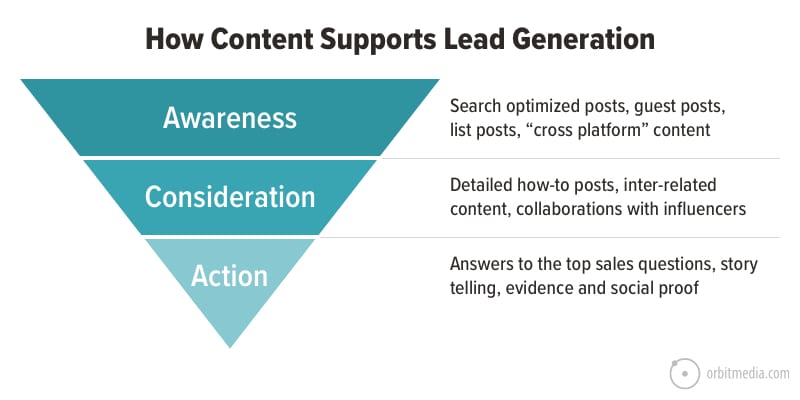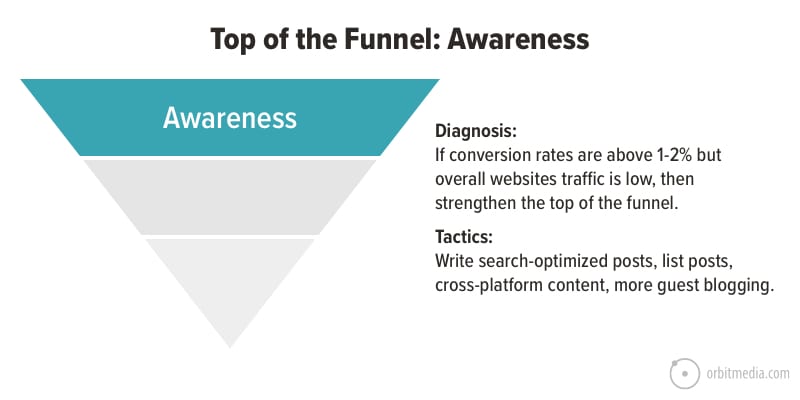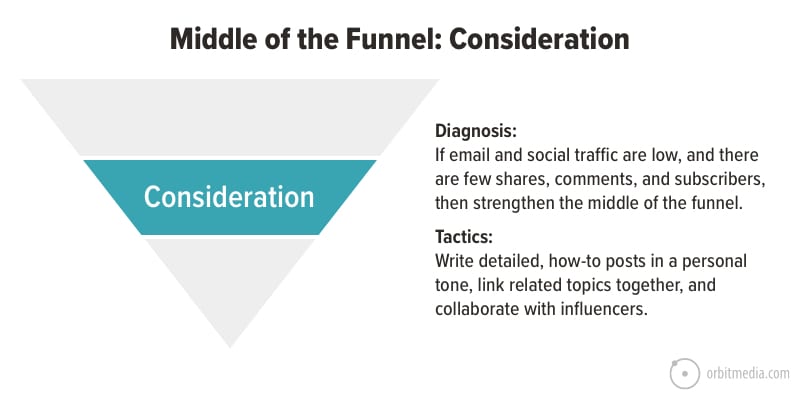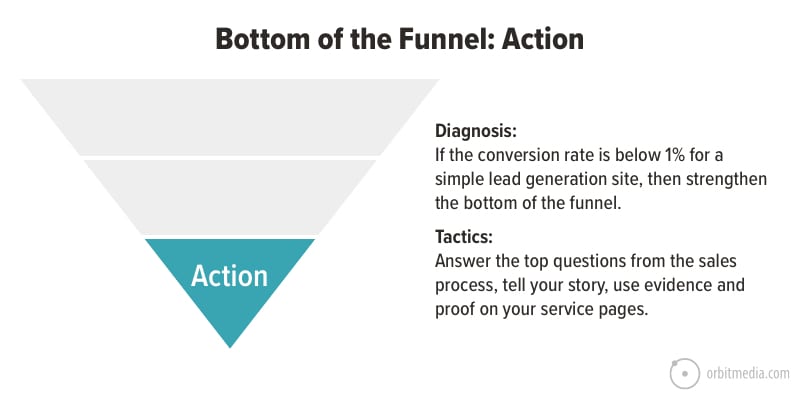Web content supports the lead generation funnel in many ways.
Some content builds awareness, pulling your audience in toward you. Other writing compels your audience to act, building trust. Specific content affects specific parts of the funnel.
So as a web content writer, you can write content to strengthen different parts of the funnel.

The “lead generation funnel” is simply a way to think about the path that each visitor takes on their way to becoming a lead. It starts with awareness and ends with action.
Not getting leads? That means there’s a weakness in your funnel.
Let’s take a look at ways to diagnose those weaknesses, and then strengthen them by writing the right kind of web content.
Top of the funnel: Awareness

Content goals: Gain attention. Increase visits. Branding. Establish general relevance.
Take a look at your analytics. If your conversion rate from visitors into leads is 2% or more, but traffic is low, there is a weakness at the top. These topics and tactics will help…
1. Search-friendly blog content
Traffic from search engines is a powerful way to fill the top of the funnel. Win a steady stream of traffic from Google by aligning your web content with relevant keyphrases. Choose phrases that are the right mix of volume (yes, people are searching for it) and competition (yes, you have a chance of ranking).
Tip: See the “Increase Targeted Traffic” post for keyword research instructions.
2. Be a guest blogger
Guest blogging fills the funnel in three ways: First, it grows your social media followings. Second, it improves your link popularity (which makes your site more likely to rank). And finally, it builds your network of friends and allies, who may later share your web content.
3. Sharable, cross-platform content
Of course you should share all of your content across all of your social networks, but it’s even better to adapt your content specifically for each platform. Record yourself presenting that blog post and publish it on YouTube. Break it up into a visual presentation and upload it to Slideshare.
Tip: See the Periodic Table of Content for ideas on repurposing content.
4. Create List posts
List posts get clicked more and shared more, increasing traffic and filling the funnel. They get clicked because they set an expectation with potential visitors: they’re structured, scan-able and include multiple items that the reader may find useful or interesting.
Middle of the funnel: Encourage consideration

Content goals: Educate, engage, get visitors to go deeper and to subscribe and follow.
If your web content has few shares and no comments, traffic from email and social campaigns is low and your email list isn’t growing, these are signs of weakness in the middle of the funnel. If your Analytics shows that repeat visits are low and the average visitor sees fewer than two pages, try these tactics and topics…
1. Write detailed, authoritative posts and pages
Truly useful “how-to” posts are the best way to increase engagement. This content demonstrates genuine expertise, positioning your site as a valuable resource. These posts that inspire visitors to share, follow and subscribe. Those are exactly the actions that lead to repeat visitors.
2. Link together related topics with relevant content
If your website has detailed information about topics A and C, but not B, then visitors will look for that information elsewhere. Ask yourself, have I missed something? Write that content and link it to the related pages through internal links.
Tip: See “Content Hubs” for tips on creating structured sets of content.
3. Co-create content with relevant influencers
Partnering with people whom your audience trusts will build your credibility. Invite relevant bloggers with legitimate social followings to contribute to your site.
If possible, contribute content to their sites. This kind of collaboration strengthens the perception of your content through the halo effect.
4. Use a personal tone, be approachable
If you want to build a community, you have to be a person. Visitors should hear your voice in your writing.
They should see the faces of your team and your authors. They should see interaction in the comments. Faceless brands aren’t memorable and impersonal websites get fewer, shorter visits. So be human!
Bottom of the funnel: Action

Content goals: Turn “suspects” into prospects. Build trust. Inspire visitors. Start a conversation.
If your website’s conversion rate is below 1%, there’s a problem at the bottom of your funnel. If your lead generation process isn’t complicated or your ecommerce checkout isn’t confusing, then the problem is probably your web content.
Here are some topics and tactics that support the bottom of your lead gen funnel…
1. Publish content that answers the top sales questions
For each prospect that contacts you with a question, there may be 100 others who didn’t bother to reach out and ask. Listen for those common sales-related questions and publish the answers on your site.
2. Show evidence that your services are valuable
Data is proof and numbers are powerful motivators. You need to use data to prove your results. If you don’t have numbers, put the voice of your customers throughout your site in the form of testimonials.
Everything you say is marketing. But when someone else says it, it’s social proof!
3. Tell stories that show your values
If list posts are for the top of the funnel, stories are for the bottom. Take time to tell the complete story of why you do what you do.
Why did the company start? What makes the business different? What do you believe in? What do you stand against?
Your story should show that you care. It should show why the work you do makes a difference!
4. Guide visitors from the blog into the marketing pages
A great marketing blog gently steers visitors toward the marketing pages. The posts should be relevant to your products or services and link to them within the text. These links guide visitors deeper into the funnel toward conversion.
Tips: Use this guide for internal linking when creating connections between content.
5. Calls-to-action throughout the site
Are you actually suggesting a next step? Are you gently nudging people to get in touch? Do you have CTAs at the bottom of all of your posts and pages? Or is each page a dead end? Guide your visitors to the contact page with quick calls-to-action on every page of the website.
Tip: Use the “How to Design a Button That Gets Clicked” article as a guide for creating calls-to-action.
6. Write articles for prospects already in your funnel
Here’s a trick that few content writers use: write content for specific leads who are already in your funnel. If you have potential clients that just aren’t ready to sign that proposal, you can address their specific concerns with content tailored just for them.
Just quickly write a post, case study or white paper that addresses their concerns. Even if it doesn’t close the deal, this content might just warm up the next lead.
“Know, like and trust”
People work with people whom they know, they like and they trust. You’ve probably heard this before.
But keep in mind, these aren’t just vague concepts. These are specific parts of your conversion funnel. Visitors are inside that funnel right now. Take a closer look, find weaknesses and fix them by writing web content tailored for each stage.




